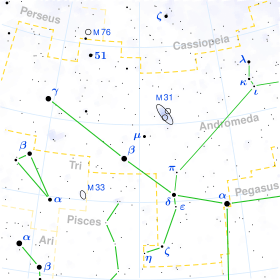HD 10307
HD 10307 (HR 483) is a binary star in the constellation Andromeda. The primary is similar to the Sun in mass, temperature and metal content. situated about 41 light-years from Earth Its companion, HR 483 B, is a little-studied red dwarf.
HD 10307 was identified in September 2003 by astrobiologist Margaret Turnbull from the University of Arizona in Tucson as one of the most promising nearby candidates for hosting life based on her analysis of the HabCat list of stars.
System
HR 483 is a binary located 41.2 ly away, in Andromeda. The two stars orbit one another elliptically (e=0.43), approaching as close as 4.2 AU and receding to 10.5 AU, with a period of just under twenty years. Due to the high margins of error on the mass estimates for the two stars, these orbital parameters are approximate.
HD 10307 A, the larger component, is a G-type main-sequence star similar to the Sun, only slightly brighter, hotter, larger, and older than the Sun—though with a slightly smaller mass. It has a low level of activity and is a candidate Maunder minimum analog.[7] HR 483 B, the smaller component, appears to be a red dwarf, with as little as thirty-eight percent the mass of the sun.[3]
The presence of a moderately close companion could disrupt the orbit of a hypothetical planet in HD 10307's habitable zone. However, the uncertainty of the orbital parameters makes it equally uncertain exactly where stable orbits would be in this system.
METI message to HD 10307
There was a METI message sent to HD 10307. It was transmitted from Eurasia's largest radar, 70-meter Eupatoria Planetary Radar. The message was named Cosmic Call 2, it was sent on July 6, 2003, and it will arrive at HD 10307 in September 2044.[8]
References
- 1 2 3 4 5 van Leeuwen, F. (2007). "Validation of the new Hipparcos reduction". Astronomy and Astrophysics. 474 (2): 653–664. arXiv:0708.1752. Bibcode:2007A&A...474..653V. doi:10.1051/0004-6361:20078357. Vizier catalog entry
- 1 2 "Sixth Catalog of Orbits of Visual Binary Stars". United States Naval Observatory.
- 1 2 3 Belikov, A. N. (1995). "Stellar Mass Catalogue (SMAC). Preliminary version". Bulletin d'Information du Centre de Donnees Stellaires. 47: 9. Bibcode:1995BICDS..47....9B.
- ↑ Holmberg, J.; et al. (July 2009), "The Geneva-Copenhagen survey of the solar neighbourhood. III. Improved distances, ages, and kinematics", Astronomy and Astrophysics, 501 (3): 941–947, arXiv:0811.3982, Bibcode:2009A&A...501..941H, doi:10.1051/0004-6361/200811191.
- 1 2 3 4 5 6 7 8 Fuhrmann, Klaus (2011). "Nearby stars of the Galactic disc and halo - V". Monthly Notices of the Royal Astronomical Society. 414 (4): 2893. Bibcode:2011MNRAS.414.2893F. doi:10.1111/j.1365-2966.2011.18476.x.
- ↑ Mamajek, Eric E.; Hillenbrand, Lynne A. (November 2008). "Improved Age Estimation for Solar-Type Dwarfs Using Activity-Rotation Diagnostics". The Astrophysical Journal. 687 (2): 1264–1293. arXiv:0807.1686. Bibcode:2008ApJ...687.1264M. doi:10.1086/591785.
- ↑ Lubin, Dan; Tytler, David; Kirkman, David (March 2012), "Frequency of Maunder Minimum Events in Solar-type Stars Inferred from Activity and Metallicity Observations", The Astrophysical Journal Letters, 747 (2): L32, Bibcode:2012ApJ...747L..32L, doi:10.1088/2041-8205/747/2/L32.
- ↑ (in Russian) http://www.cplire.ru/rus/ra&sr/VAK-2004.html
External links
| Wikimedia Commons has media related to Canes Venatici. |
